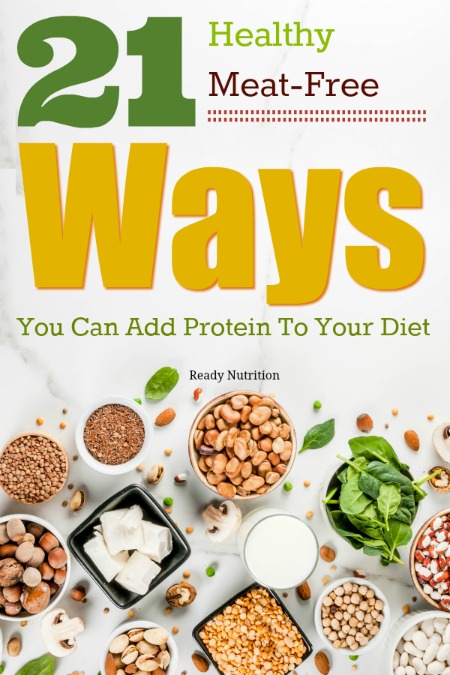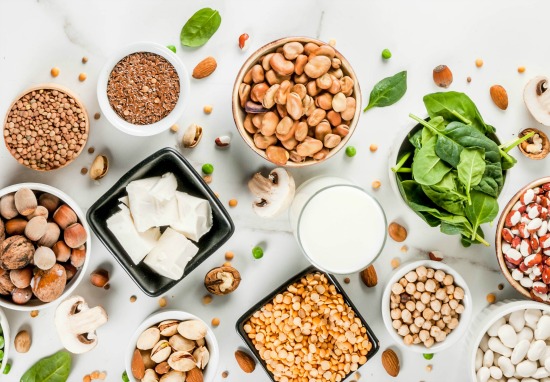Every living cell in your body uses protein for structural and functional purposes. It is important to get enough in your diet for that reason.
Protein is made up of amino acids, which are building blocks for our bodies. There are 20-plus amino acids, and they help form thousands of different proteins (there are at least 10,000!) in the body. Because we don’t store amino acids, our bodies make them in two different ways: either from scratch or by modifying others. There are nine amino acids that are known as essential amino acids because they must come from food. They are histidine, isoleucine, leucine, lysine, methionine, phenylalanine, threonine, tryptophan, and valine.
Dietary protein is one of three macronutrients that make up our diets (the other two are carbohydrates and fat). Of those, protein is the most satiating – that, is, it is the most filling.
If we consume excess protein in our diets, our bodies will usually find a way to use it – we don’t store a lot of extra amino acids like we do extra carbohydrates and fat.
Because we either use or excrete extra protein, we need to replenish it through our diets.
How much dietary protein do you need?
Daily protein needs vary among individuals. Body composition, activity level, and overall health are factors that need to be considered when calculating or estimating protein needs.
A VERY general guideline is one gram of protein per pound of body weight for healthy adults. Muscle maintenance (having a good amount of muscle makes losing fat easier) requires adequate protein in your diet.
I don’t mean that you need to become a bodybuilder, so don’t worry. Having a healthy amount of muscle is important for everyone because it makes everyday tasks easier, helps boost your metabolism, reduces your risk of injury, improves your posture, helps prevent (and reduce) chronic back pain, and contributes to overall health and longevity. As we age, we naturally lose some muscle mass (this is called sarcopenia), but the good news is that we can prevent it with adequate protein consumption and regular exercise, especially strength training.
It is important to remember that eating protein in itself will not help you gain muscle, but it may help you keep what you already have.
When you eat too little calories for an extended period of time, your precious muscle is one of the things that your body will start to get rid of! Your body needs enough calories for energy and will break down your muscle tissue and use it for energy if you aren’t eating enough.
This protein calculator will help you calculate your needs.
Is too much protein bad for health?
Common myths about high protein intake persist, despite the fact that there really isn’t any evidence to support them. Protein does not “leach” calcium from your bones and causes osteoporosis, and it does not cause kidney damage (UNLESS you have existing kidney disease – in that case, please ask your physician for guidance).
What is a “complete” protein?
Some proteins found in food are “complete”, meaning that they contain all of the 20-plus amino acids the body needs. Animal-based sources of protein tend to be complete, while plant-based sources tend to lack one or more essential amino acid. If you are a vegetarian or a vegan, be sure to eat a wide variety of protein-containing plant foods every day to make sure you get all of the amino acids your body needs.
All protein sources are not created equal.
People tend to think of animal products when considering protein sources. But, some of them come with possible health risks that are worth keeping in mind. Ideally, you will get your protein from a wide variety of foods.
Diets high in red meat have been linked with a higher risk of developing certain diseases, including cancer.
A large body of scientific evidence shows that eating healthy protein sources like beans, nuts, fish, or poultry in place of red meat and processed meat can lower the risk of several diseases and premature death. There are more than 100 published epidemiological studies that show a relationship between eating meat and cancer risk. However, researchers still aren’t sure if meat itself can lead to the development of cancer, or if the problem is related to the fact that meat eaters tend to eat less healthy food overall. The increased disease risk may actually be because people who consume a lot of meat are eating a diet high in calories and saturated fat and low in fiber, antioxidants, vitamins, and minerals. In other words, there is an association with red meat and cancer, but causation has not been established. If you eat red meat and want to know how to make it healthier, please see this resource from Examine.com.
Even if you are not interested in cutting red meat from your diet, eating less and adding more plant-based sources of protein is a good idea.
Plant-based eating can save you money.
Buying good quality meat, poultry, seafood, and eggs can be quite expensive. Free-range, cage-free, pastured, grass-fed, organic – animal products that are produced with those standards are generally better for health, the environment, and of course, better for the animals, but buying them regularly can really add up and is not affordable for many.
Plant-based sources of protein, on the other hand, tend to be quite affordable. And, many of them have a much longer shelf life than animal sources. Yes, there are many expensive plant-based foods on the market, like fake “meat” products, veggie burgers, and coconut milk dairy substitutions. Thankfully, none of those items are necessary. Instead, focus on adding fresh, minimally processed, nutrient-rich, plant foods like fruits, vegetables, whole grains, nuts, seeds, beans, and legumes to your diet. All of these items are affordable for most people.
Raising animals for food may be harming the environment.
Evidence suggests that raising livestock (particularly factory farming) and industrial fishing has ecological impacts. And, food production places an enormous demand upon our natural resources, as agriculture is a major contributor to deforestation, species extinction, and freshwater depletion, and contamination. Eating plants are more environmentally sustainable.
Here’s a big list of plant-based sources of protein.
- Wild rice: 7 grams protein per cup (cooked)
- Quinoa: 9 gr per cup
- Amaranth: 8 gr per cup (cooked)
- Buckwheat: 13 gr protein for a 100-gram serving
- Beans: about 15 gr per cup, depending on the variety
- Lentils: 18 grams per cup
- Nuts and nut butter: 5-9 gr protein per ounce, generally.
- Seeds: varies, but here are a few high-protein examples – pumpkin seeds (4 gr for 1 ounce), sunflower seeds (7 gr for 1/4 cup), chia (6 gr for 2 tablespoons)
- Green peas: 9 gr per cup (cooked)
- Hemp – protein powder (about 15 gr per serving), hemp seeds, also called Hemp Hearts (10 grams in 3 tablespoons)
- Edamame: 17 grams per cup
- Tofu: 9 grams in a 3-ounce serving
- Tempeh: 16 grams in 1/2 cup
- Textured vegetable protein (TVP): 12 gr in 1/4 cup
- Seitan: 25 grams in 3.5-ounce serving (This is wheat gluten, so avoid this if you have Celiac disease or can’t tolerate gluten)
- Nutritional yeast: 14 gr per ounce
- Spelt and teff: about 10 gr per cup (cooked)
- Spirulina: 8 gr in two tablespoons
- Sprouted grain breads: varies
- Oatmeal: 6 grams per cup (cooked)
- Protein-rich fruits and vegetables: broccoli (6 gr per cup), spinach (5 gr per cup), and 4-5 gr protein per cooked cup of asparagus, artichokes, potatoes, sweet potatoes, and Brussels sprouts. Fresh fruits generally have a lower protein content than vegetables. Those containing the most include guava, cherimoyas, mulberries, blackberries, nectarines and bananas, which have about 2–4 grams of protein per cup.
There are a few special concerns to keep in mind about plant-based protein sources.
Lectins
Lectins are a type of carbohydrate-binding protein that sticks to cell membranes in the digestive tract. They are sometimes are referred to as “anti-nutrients,” and are found in most plant and animal foods. However, they’re found in the highest amounts in beans, legumes, nightshade vegetables (tomatoes, potatoes, peppers, and eggplant), dairy products, peanuts, chickpeas, and all grains. Some types of lectins, like ricin, are toxic, but others are not.
Entirely avoiding lectins is difficult and requires following a very restrictive diet.
In What is a Lectin-Free Diet? Healthline explains that people who have food sensitivities or are prone to gastrointestinal problems may feel better on a low (or no) lectin diet:
Eating large amounts of food containing lectin may cause gas or gastric distress in some people. Lectin is not digestible. It binds to cell membranes lining the digestive tract. There, it may disrupt metabolism and cause damage.
***
Some research notes that lectin can disrupt digestion and cause intestinal damage if eaten in large quantities over a prolonged period of time.
You can destroy most lectin in foods by cooking them, as Healthline explains:
It is important to avoid raw, soaked, or undercooked beans, such as kidney beans, which have been found to be toxic to people due to their lectin levels. According to one study reported in the South African Medical Journal, soaking beans is not enough to remove lectin content.
“Fermenting, as well as soaking and sprouting high-lectin foods, can drastically reduce the lectin content, making them safe to eat for most people,” as Dr. Brian Mowll explains in What Are Lectins And Why Should You Care?
Arsenic
Arsenic, a toxic trace element that has been linked to health problems, has been found in all types of rice, but wild rice and brown rice are particularly susceptible to contamination. Arsenic can accumulate in the bran of rice crops grown in polluted areas. In an article titled Arsenic In Rice: How Concerned Should You Be? Food Revolution Network shared some startling information:
Consumer Reports tested 223 samples of rice products and found significant levels of arsenic in almost all of them, including white, brown, parboiled, jasmine, basmati, and other types of rice.
You can see the full results of the brands they tested and the results here.
Arsenic was found in rice whether it was organic or conventional — and from all regions of the world.
Thankfully, there are ways to reduce the arsenic in rice:
To some extent, arsenic can be washed off. Arsenic is water soluble.
Published studies indicate that cooking rice in excess water (from six to 10 parts water to one part rice), and draining the excess water, can reduce 40 to 60% of the inorganic arsenic content, depending on the type of rice.
And a 2015 study published in PLOS ONE, found a cooking method that reduced arsenic by 85%. They used a filter coffee maker to pass the hot water through the rice as it cooked. (source)
Rinse rice thoroughly before cooking it, or better yet – soak it for 48 hours before cooking. Pour off the water and rinse the rice every 8 to 12 hours (like soaking beans). If you want to try using a coffee maker to reduce the arsenic content in your rice, here’s how to do that. Whichever method you choose, be sure to use filtered water – because water is often contaminated with arsenic too.
As you can see, eating a wide variety of foods is important, not only to ensure that you get a lot of nutrients but also to help you avoid toxins associated with high consumption of certain foods.
And, no matter which protein sources you choose, consider growing your own food or buying locally when possible.
Be well!

This article was originally published at Ready Nutrition™ on March 20th, 2019








Excelente